BHUTAN
Overview of SRI in Bhutan
In 2006, Bhutan became the 28th country to report SRI benefits after Karma
Lhendup, then with the Sherubtse College in eastern Bhutan, showed yield increases
in a set of replicated trials of SRI methods at three
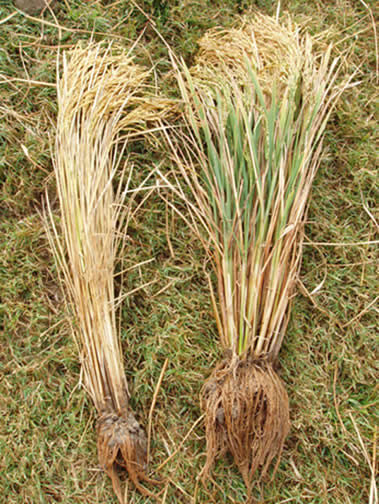 locations in Kanglung district. These early trials did not incorporate organic
matter or include soil aeration. More complete trials led by Lhendup together with
the College of Natural Resources of the Royal University of Bhutan and by Mahesh
Ghimire at the Renewable Natural Resources Research Centre at Bajo continued during
2007 and 2008 (see CNR report and RNRRC report). Results showed a yield improvement with
SRI accompanied by lower requirements for seeds and water; reduced crop cycle (by as
much as 15 days), and reduced infestation by Potamogeton distinctus, a
weed that badly affects rice crops in the region. CNR and RNRRC 2008 trial results were presented at a 2009 SRI workshop along with results from four
districts where SRI methods were tried by Department of Agriculture staff. The MOA
and DOA officials present gave full support to 2009 trials and planned a similar
review at the end of the year to consider expanded experience and to plan for 2010
expansion. Growing interest in SRI in Bhutan led to an SRI study tour by
researchers and district agricultural officers to India and Nepal in October 2009
(see report with recommendations and
action plans).
locations in Kanglung district. These early trials did not incorporate organic
matter or include soil aeration. More complete trials led by Lhendup together with
the College of Natural Resources of the Royal University of Bhutan and by Mahesh
Ghimire at the Renewable Natural Resources Research Centre at Bajo continued during
2007 and 2008 (see CNR report and RNRRC report). Results showed a yield improvement with
SRI accompanied by lower requirements for seeds and water; reduced crop cycle (by as
much as 15 days), and reduced infestation by Potamogeton distinctus, a
weed that badly affects rice crops in the region. CNR and RNRRC 2008 trial results were presented at a 2009 SRI workshop along with results from four
districts where SRI methods were tried by Department of Agriculture staff. The MOA
and DOA officials present gave full support to 2009 trials and planned a similar
review at the end of the year to consider expanded experience and to plan for 2010
expansion. Growing interest in SRI in Bhutan led to an SRI study tour by
researchers and district agricultural officers to India and Nepal in October 2009
(see report with recommendations and
action plans).
SRI experimental successes, including those at higher altitude, are detailed in 2009 Journal of Renewable Natural Resources - Bhutan articles on performance of four varieties under SRI at Lobesa and IR64 results in Wandgue and Punakha, with IR64 yields averaging 10.1 t/ha. On the farmer's field at Sopsokhe in which IR64 was used with both SRI methods and farmer practice, the SRI yield was 9.6 t/ha (40% higher) compared to 6.6 t/ha with usual methods. During 2009, extension efforts in Deorali Geog have produced encouraging results with farmer yields well above the national average of 3.5 tons/ha. Ngawang Chhogyel, Senior Research Officer and 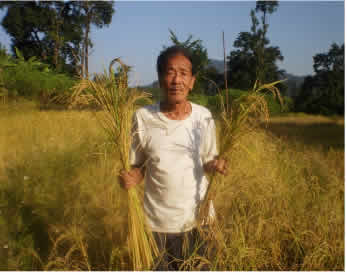 Coordinator Department of Agriculture's National Rice Program in Bhutan, presented a poster on SRI at the 4th International Rice Congress in Thailand (2014) that detailed 2010-2013 SRI experiments showing an average grain yield ranging from 4 -7 t/ha.
Coordinator Department of Agriculture's National Rice Program in Bhutan, presented a poster on SRI at the 4th International Rice Congress in Thailand (2014) that detailed 2010-2013 SRI experiments showing an average grain yield ranging from 4 -7 t/ha.
Though Bhutan is only 50% self-sufficient in rice, it is the most important and preferred cereal of the there. In a 2013 article about Bhutan's plans to go 100% organic, Pema Gyamtsho, Bhutan's minister of agriculture and forests, says that the government has been experimenting with SRI since it has been shown elsewhere to increase crop yields with no synthetic chemicals. The Samdrup Jongkhar Initiative (SJI), a community-based organization is committed to contribute towards the national vision of going fully organic, decided to focus on organic rice production. During 2014, the SJI initiated SRI projects in Phuntshothang, Pemmathang and Langchephu Gewogs. A higher yield was obtained in Langchenphu with SRI and a 28% increase was recorded in Pemathang. In 2016, SJI added a pilot in Rekhay village in Dewathang Gewog. After initial success, 11 farmers were trained in 2017, and in 2019, the number of SRI farmers became 23 --over half of the farmers living there. Rekhay village has become a model for SRI and organic rice production in Samdrup Jongkhar, with 60% yield increases under SRI. Building on SJI’s successful implementation of the SRI project at Rekhay village, SJI farmers trained members of the Marangdut Farmers’ Group in Pangbang, who also learned to prepare and apply bio-pesticides and organic liquid fertilizer. And, after eighteen years, Menchari village is finally reviving paddy cultivation with the initiative of the youth group and a lead farmer in the community, beginning with a one-acre SRI project that will be up scaled from next year with a necessary support from relevant agencies. This is expected to increase in their food self-sufficiency and reduce import of chemical-laden rice from India. It is also in accordance with the government’s target of enhancing rice sufficiency by 15% during the 12th five year plan.
Progress and Activities
2019 Updates
 System of Rice Intensification at Marangdut in Pangbang
System of Rice Intensification at Marangdut in Pangbang
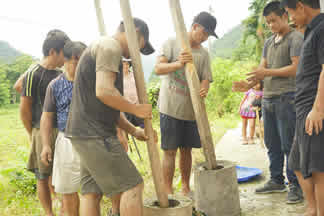 [July 28, 2019] After a successful paddy seedling preparation using SRI methods in phase one, members of the Marangdut Farmers’ Group in Pangbang are now trained in the SRI method of paddy transplanting. The group members also learned to prepare and apply bio-pesticides (see photo at right) and organic liquid fertilizer. The Samdrup Jongkhar Initiatives (SJI) and the farmers' group were thankful for the Bhutan Foundation's continued support in promoting organic rice production using SRI methods. An August 5 facebook post by the Bhutan Foundation provided photos and further information that the lead farmer from SJI emphasized the importance of close monitoring after transplantation the need for bio-pest control to keep insects from damaging the paddies. He led step by step demonstrations on the processes to create organic pest control. Most importantly, he noted, was that the organic pest control drives away insects by its strong smell without any life being harmed.
In the upcoming third phase, the the SJI and Marangdut Farmers' Group will do an assessment of the progress of the SRI method and share challenges faced in its mitigation.
The farmers said they are excited to see the yield and thanked both Bhutan Foundation and SJI for it continued support. [Additional photos of this event are available in a July 28 article by the Samdrup Jongkhar Initiative and on the Bhutan Foundation facebook page.]
[July 28, 2019] After a successful paddy seedling preparation using SRI methods in phase one, members of the Marangdut Farmers’ Group in Pangbang are now trained in the SRI method of paddy transplanting. The group members also learned to prepare and apply bio-pesticides (see photo at right) and organic liquid fertilizer. The Samdrup Jongkhar Initiatives (SJI) and the farmers' group were thankful for the Bhutan Foundation's continued support in promoting organic rice production using SRI methods. An August 5 facebook post by the Bhutan Foundation provided photos and further information that the lead farmer from SJI emphasized the importance of close monitoring after transplantation the need for bio-pest control to keep insects from damaging the paddies. He led step by step demonstrations on the processes to create organic pest control. Most importantly, he noted, was that the organic pest control drives away insects by its strong smell without any life being harmed.
In the upcoming third phase, the the SJI and Marangdut Farmers' Group will do an assessment of the progress of the SRI method and share challenges faced in its mitigation.
The farmers said they are excited to see the yield and thanked both Bhutan Foundation and SJI for it continued support. [Additional photos of this event are available in a July 28 article by the Samdrup Jongkhar Initiative and on the Bhutan Foundation facebook page.] System of Rice Intensification (SRI) Method Continues to Expand in Rekhay Community
System of Rice Intensification (SRI) Method Continues to Expand in Rekhay Community
[July 8, 2019] Despite apprehensions and challenges with promoting organic SRI with the Rekhay community, the experience has overall been very encouraging with more farmers coming forward in last few years. The project was initially started with one farmer in 2016 and as of 2019 has grown to over than 23 farmers-- over half of Rekhay's rice growers. SJI is hopeful that, in couple of years from now, Rekhay village will become a model for SRI and organic rice production in Samdrup Jongkhar. Generally, there are 60% yield increases under SRI method compared to the conventional system. The most notable advantages of SRI method according to the Rekhay farmers are – higher yield, need less seed, and requires less water as compared to the conventional practice. Further, SJI is currently up-scaling the SRI
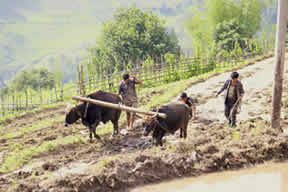 method of paddy cultivation at Marangdut community in Panbang in collaboration with the Bhutan Foundation from this season (see item directly above). In fact, Bhutan Foundation has funded SJI's first SRIproject at Rekhay in 2016.
[This information is from a July 8 article by the Samdrup Jongkhar Initiative article.]
method of paddy cultivation at Marangdut community in Panbang in collaboration with the Bhutan Foundation from this season (see item directly above). In fact, Bhutan Foundation has funded SJI's first SRIproject at Rekhay in 2016.
[This information is from a July 8 article by the Samdrup Jongkhar Initiative article.] Reviving Paddy Cultivation in Menchari Village
Reviving Paddy Cultivation in Menchari Village
[June 12, 2019] After 18 years, Menchari village is finally reviving paddy cultivation with the initiative of youth group and lead farmer in the community. Initially, an acre of land is being cultivated as a pilot. The area will be up scaled from next year with a necessary support from relevant agencies. This will build on SJI’s successful implementation of System of Rice Intensification (SRI) project at Rekhay village in Dewathang. This is expected to increase in their food self-sufficiency and reduce import of chemical laden rice from India. It is also in accordance with the government’s target of enhancing rice sufficiency by 15% during the 12th five year plan. According to the youth group, vegetables will be cultivated during winter on same field to intensify production from a limited arable area. [See Samdrup Jongkhar Initiative article.]
2018
 Positive SRI Experiences Lead to Expansion to New Areas
Positive SRI Experiences Lead to Expansion to New Areas
[July 25, 2018] SRI results from 2015 showed a 52% yield increase in Pemathang and a 19% increase in Phuntshothang. In Rekhay/Dewathang, the increase recorded in 2016 was 122% and in 2017, 60%. The major advantages cited by farmers were less seed needed and water-savings. Based on the results and farmer opinion, SJI decided to scale up SRI to other areas, and in addition, to promote use of traditional varieties like Khamti, which fetches a higher price. SJI is also collaborating the Jigme Namgyel Engineering College at Dewathang to develop SRI weeders. SJI decided to sent SRI farmers from Rekhay village to train farmers of Toktokha village in Chhukha and Phajogoenpa in Lauri Gewog in Samdrup Jongkhar Dzongkhag as part of projects under Austrian Coordination Office and HELVETAS, Bhutan. SJI is also incorporating SRI components in the Lead Farmers training supported by the Commercial Agriculture Resilient Livelihoods Enhancement Program (CARLEP) through the Agriculture and Research Development Centre- Wengkhar. [See SJI article for more information.]
2017
 Visit To Assam
Visit To Assam SRI Expands in Rekhey village in Dewathang Gewog
SRI Expands in Rekhey village in Dewathang Gewog
[May 20 and June 17, 2017] A successful implementation of the SRI project with one farmer in Rekhey village under Dewathang Gewog in 2016 resulted in up-scaling of SRI with 11 additional farmers. These 11 farmers were trained in SRI methods, promised ongoing support, and had started preparing seedlings in mid-June which were to be transplanted after 14 days. An SRI manual was planned as part of the larger efforts towards building farmers’ capacity and continuing to up-scale SRI in the coming years. This also aligns with the government’s target of enhancing rice sufficiency by 15% during the 12th five year plan. More than 100 volunteers from Jigme Namgyel Engineering College (JNEC) and Chokyi Gyatso Institute (CGI) together with SJI staff took part in a day-long rock collecting, which yielded approximately two truckloads of small rocks from an area of 2 ½ acres. [See articles from May 20, 2017 and June 17, 2017]
[June 26, 2017] In order to enhance the local capacity of SJI's SRI farmers and to upscale the SRI project in the coming years with support from local leaders 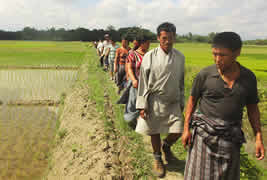 /development actors, SJI took a mixed group of 26 people (SRI farmers from Rekhay, Agriculture officials, representatives from Gewog administration and SJI staff) to Guwahati, Assam, on June 24 – 25, 2017. They were able to witness the SRI field in Assam (shown at right) and learn some new techniques/methods.
Apart from SRI, they also visited the vermicompost production centre of Lauhitya Livelihood private Ltd. and Organic Majuli’s outlet in in an organic bazaar. Manash Chaliha organized the visit and hosted the group from Bhutan.
/development actors, SJI took a mixed group of 26 people (SRI farmers from Rekhay, Agriculture officials, representatives from Gewog administration and SJI staff) to Guwahati, Assam, on June 24 – 25, 2017. They were able to witness the SRI field in Assam (shown at right) and learn some new techniques/methods.
Apart from SRI, they also visited the vermicompost production centre of Lauhitya Livelihood private Ltd. and Organic Majuli’s outlet in in an organic bazaar. Manash Chaliha organized the visit and hosted the group from Bhutan.
2016
 System of Rice Intensification (SRI) Crop Cut Day in Rekhey Village
System of Rice Intensification (SRI) Crop Cut Day in Rekhey Village
[November 14, 2016] The SRI pilot project with one farmer in Rekhey village in Dewathang Gewog has been successful. Gross yield of 2156 kg/acre was noted in SRI method, while 1176 kg/acre in conventional method – in conversion to an acre; the difference is 980 kg/acre. Along with the crop cut, awareness has been created among the farmers and 13 of them from Rekhey village has come forward and registered with SJI to adapt SRI methods from next season. These farmers will be further trained on SRI methods and provide necessary support wherever they require with SRI project support from Bhutan Foundation. The crop cut day was observed in presence of Assistant Dzongkhag Agriculture Officer (ADAO), Dewathang Gewog Agriculture Extension Officer (AEO), farmers from Rekhey and Menchari villages, students from Chokyi Gyatso Institute and SJI staff. Note:- This is raw information collected immediately after the harvest. Final comparative figure will be posted duly after the analysis. [See SJI article]
 Civil Society Cooperation to Support SRI Introduction
Civil Society Cooperation to Support SRI Introduction
[October 15, 2016] After early trials of SRI methods by SJI, it was clear that with wider spacing, weeds would be a constraint unless mechanical weeders could be used. Colleagues in the NGO WASSAN in Hyderabad, India, offered to send three Mandava weeders that could be used as models for local manufacture. Through a flurry of email communications, it was arranged to send the weeders from Hyderabad to New Delhi, where a Bhutanese monk who often traveled between New Delhi and Bhutan agreed to transport them personally to the Bhutanese border at which point SJI could take possession of them. SJI subsequently had 22 weeders fabricated in Bhutan to distribute to farmers who were working with SJI to introduce and evaluate SRI in their region. This was an example of civil society cooperation and solidarity across national borders.
 Samdrup Jongkhar Initiative Expands SRI Training during 2016
Samdrup Jongkhar Initiative Expands SRI Training during 2016
[September 17, 2016] In mid-July, 2016, the Samdrup Jongkhar Initiative (SJI), a civil society organization based in the Samdrup Jongkhar dzongkhag, reported that a pilot SRI site has begun at Rekhay (Dewathang Gewog). The past pilot areas were in Phuntshothang, Pemmathang and Langchephu Gewogs, had been difficult to monitor due to their remote locations. Rekhay farmers have received hands-on experience with SRI planting methods. The seeds were sown normally (without any bed preparation) except for the addition of manure. Seventeen-day-old days old seedlings with 2-3 leaf stage were transplanted (one seedling per hill, 2-3cm deep with a spacing of 25cm x 25cm) with seed sac attached to the roots. (The usual method of planting rice is 2-3 seedlings at 45 days old.) The field was irrigated and prepared on the same day of the plantation. "Jeevamrit" was added the night before leveling of the terrace by the farm machine and irrigation.
A September 17 article in The Bhutanese further reported that Jigme Namgyel Engineering College will be part of the SJI program through creation of appropriate technology for the field. SJI also plans to bring farmers from other villages to the SRI sites to raise awareness and build confidence in SRI. Results of the SRI program are to be disseminated to farmers around the country through the AEO-SJI network, SJI’s social media platform.
2014-2015
 Farmers Successful in Raising Yields with SRI in Samdrup Jongka
Farmers Successful in Raising Yields with SRI in Samdrup Jongka
[March 16, 2015] Yangchen Rinzin reported on successful SRI efforts that began during June 2014 with a training by agriculture officials in the village of Pemathang in Samdrup Jongkar, Bhutan. According to the article in Kuensel, the farmers have no regrets now as "they are reaping the benefits of the change." Sangay Wangdi, a farmer who tried the new SRI methods on his 30-decimal land, produced 2,250 kg of rice as opposed to the his usual 1,500 kg. While farmers are happy with the yield, some are concerned about the increase in labor requirements and others are worried about pests if agricultural chemical are not used. The dzongkhag’s agriculture extension officer Wangchuk explained that SRI methods would intensify rice production, while using fewer, younger, rice seedlings transplanted singly with 25 X 25cm spacing at 8 days old as opposed to 45+ days like in normal cultivation. He also noted that one kilogram of seeds would then be required rather than the 10 kg they use normally, but that each plant would produce more tillers. Wangchuk's project data indicated that SRI plots produced about 2807.9 kg of paddy from an acre of land, while the normal method produced 2,025 kg. With these positive results, he is encouraging more farmers to adopt SRI and scale up its use in order to maximize use of small land holdings. During March 2015, a follow-up project was considered to introduce simple weeders designed in India, though no firm plans have yet emerged.
An article from 2014 outlined the beginning of the project in Pemathang, which was funded by the Sandrup Jongkhar Initiative and carried out together with the agriculture extension office in Samdrupcholing in order to encourage organic farming. Among SRI's other advantages, Wangchuk noted that SRI methods require less water. While the normal paddy fields require continuous water supply or an irrigation channel, he added that SRI just needs enough water to keep the land moist, which will be useful at a time when farmers are often faced with water shortage and erratic rainfall. Farmers have made small outlets in the field to draw excessive water in case of heavy rain. The original plans called for the rice to be sold to the Food and Corporation of Bhutan.
 Presentation on SRI in Bhutan at the 4th International Rice Congress in Thailand
Presentation on SRI in Bhutan at the 4th International Rice Congress in Thailand
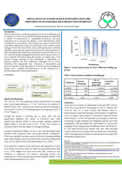 [November 10, 2014] Ngawang Chhogyel, Senior Research Officer and Coordinator Department of Agriculture's National Rice Program in Bhutan presented a poster at the 4th International Rice Congress, which was held October 27-31, 2014, at the Bangkok International Trade and Exhibition Centre (BITEC) in Thailand. The poster, Application of System of Rice Intensification (SRI) principles in sustainable rice production in Bhutan, was prepared by Chhogyel together with Mahesh Ghimirey and Yadunath Bajgai. It details the 2010 to 2013 SRI experiments that showed that an average grain yield ranging from 4 -7 t/ha with about 22 numbers of effective tillers per hill. Similarly, the result from the 2013 experiment which used 10-15 day-old seedlings gave an average grain yield of 5 t/ha. Though the effects of seedling age on grain yield was not significantly different, the values of root-shoot ratio were significantly affected and younger seedlings exhibited higher values of root-shoot ratio (0.174 - 0.198). The numbers of productive tillers were also higher for younger seedlings. Increased tillering and higher root-shoot ratio indicated higher yield potential under minimum water and proper nutrient management. Also of note was a gradual decrease in grain yield with increasing seedling ages. Higher root shoot ratio under SRI condition has been attributed to improved soil aeration supporting growth and multiplication of soil organisms that provide multiple benefits to the plants.
[November 10, 2014] Ngawang Chhogyel, Senior Research Officer and Coordinator Department of Agriculture's National Rice Program in Bhutan presented a poster at the 4th International Rice Congress, which was held October 27-31, 2014, at the Bangkok International Trade and Exhibition Centre (BITEC) in Thailand. The poster, Application of System of Rice Intensification (SRI) principles in sustainable rice production in Bhutan, was prepared by Chhogyel together with Mahesh Ghimirey and Yadunath Bajgai. It details the 2010 to 2013 SRI experiments that showed that an average grain yield ranging from 4 -7 t/ha with about 22 numbers of effective tillers per hill. Similarly, the result from the 2013 experiment which used 10-15 day-old seedlings gave an average grain yield of 5 t/ha. Though the effects of seedling age on grain yield was not significantly different, the values of root-shoot ratio were significantly affected and younger seedlings exhibited higher values of root-shoot ratio (0.174 - 0.198). The numbers of productive tillers were also higher for younger seedlings. Increased tillering and higher root-shoot ratio indicated higher yield potential under minimum water and proper nutrient management. Also of note was a gradual decrease in grain yield with increasing seedling ages. Higher root shoot ratio under SRI condition has been attributed to improved soil aeration supporting growth and multiplication of soil organisms that provide multiple benefits to the plants.The poster (right) concludes that SRI could fit well for a small country like Bhutan, which is characterized by small land holdings and an abundance of vegetation cover for organic matter supply. The authors feel that it is possible to raise the current yield ceiling of 3.2 t/ha in Bhutan by adopting some principles of SRI such as planting younger seedlings and integrated nutrient and water management. In addition, SRI principles offer opportunities to cope up with emerging climate change issues and enhance water use efficiency, which could help resource-limited farmers who face water shortage, loss of soil quality and an increasing costs of fertilizer. SRI's ability to increase plants’ resilience to stresses such as drought can also lessen the penalty on grain yield.
2013 Updates
 Bhutan to Go Organic - SRI Has a Role to Play
Bhutan to Go Organic - SRI Has a Role to Play
A February 11 article in the Guardian's PovertyMatters blog discusses Bhutan's plans to become the first country in the world to have 100% organic agriculture; sale of pesticides and herbicides will be banned and animal and green manure will be used for fertilizing crops. Although farmers will be expected to grow more for themselves as well as for export to India, China and other countries, the Government does not believe that shifting to organic agriculture will reduce production. Pema Gyamtsho, Bhutan's minister of agriculture and forests, said that the decision to go organic was both practical and philosophical: Most farmers are already organic anyway and the government wants to protect the environment, which is in line with Buddhist thinking. Like most members of the cabinet, he is a farmer himself and has studied western farming methods in New Zealand and Switzerland. He concedes that going organic will take time and there is no set no deadline. He added, "Bhutan's future depends largely on how it responds to interlinked development challenges like climate change, and food and energy security."
As rice has become increasingly popular in the Himalayan country of 1.2 million, Bhutan currently imports it. Hence, SRI (called "Sustainable Root Intensification" instead of System of Rice Intensification in the article) which has shown that organic crop yields can be doubled with no synthetic chemicals, is being studied. "We are experimenting with different methods of growing crops like SRI, but we are also going to increase the amount of irrigated land and use traditional varieties of crops which do not require inputs and have pest resistance," says Gyamtsho.
For 2005-2009 activities, see Bhutan Activity Archives
Reports and Articles
- Samdrup Jongkhar Initiative. 2019. System of Rice Intensification at Marangdut in Pangbang. Samdrup Jongkhar Initiative website. July 28.
- Samdrup Jongkhar Initiative. 2019. System of Rice Intensification (SRI) method with Rekhay community. Samdrup Jongkhar Initiative website. July 8.
- Samdrup Jongkhar Initiative. 2019. Reviving paddy cultivation. Samdrup Jongkhar Initiative website. June12.
- 2018. Success story of SJI- System of Rice Intensification (SRI). Samdrup Jongkhar Initiative website. October 5.
- Dema, Karma, Ngawang Chojey, and Pema Chophel. 2018. System of Rice Intensification for organic rice production- An experience of Samdrup Jongkhar Initiative. Samdrup Jongkhar Initiative website. October.
- Samdrup Jongkhar Initiative. 2017. Visit to Assam. Samdrup Jongkhar Initiative website. Samdrup Jongkhar Initiative. June 26.
- Samdrup Jongkhar Initiative. 2017. System of Rice Intensification (SRI) Project Samdrup Jongkhar Initiative website. June 17.
- Samdrup Jongkhar Initiative. 2017. SRI Project. Samdrup Jongkhar Initiative website. May 20.
- Zangmo, Tanden. 2016. Samdrup Jongkhar Initiative up scaling SRI. The Bhutanese, September 17. [Rekhey village chosen at new pilot area; Pemathang and Langchenphu gewogs began with SRI in 2014]
- SJI. 2016. SRI being piloted at Rekhay for the first time. Samdrup Jougkhar Initiative website. July 6. [Samdrup Jongkhar Initiative has begun piloting SRI at Rekhay (Dewathang Gewog), Bhutan.]
- Samphel, Norbu, Erik Landry, and Emily Green-Tracewicz. 2015. System of Rice Intensification - A case study from Bhutan. Samdrup Jougkhar Initiative website. October.
- Rinzin, Yangchen C. 2015. System works, but farmers still skeptical. Kuensel Online, March 16. [Villagers of Pemathang in Samdrupjongkar gets much higher yield with SRI, but wonder about labor.]
- Rinzin, Yangchen C. 2014. A new method of cultivating rice. Kuensel Online, September 2.
- Vidal, John and Annie Kelley. 2013. Bhutan set to plough lone furrow as world's first wholly organic country. PovertyMatters blog (The Guardian). February 11.
- Lhendup, Karma and M. Ghimiray. 2010. An organic approach to increase rice yield in Bhutan. Bhutan Observer. October 6
- Lhendup, Karma. 2008 (December). Promotion of SRI method through CNR trainees. Annual Magazine. Vol. 16:26-27. College of Natural Resources, Royal University of Bhutan, Lobesa. System of Rice Intensification website. (2p., 157KB pdf).
- Khawas, Suraj, and T. Tobgay. 2008. More rice from SRI. RC-Bajo Muensel 2(2008):5-6. Bhutan. (248KB pdf). [Article from Bhutan available on the System of Rice Intensification website]
- Lhendup, Karma. 2007 (November). SRI: A corrective method of rice production. Annual Magazine. Vol. 15:23-25. College of Natural Resources, Royal University of Bhutan, Lobesa. (3p., 1.68MB pdf). [Article from Bhutan available on the System of Rice Intensification website]
- Chhetri, Mamta. 2007. Report on SRI at Khachadrapchu in 2007 Cropping Season. Ministry of Agriculture, Bhutan. System of Rice Intensification website. (2p., 30KB)
- Lhendup, Karma. 2006. Ongoing Feasibility Study of the System of Rice Intensification (SRI) in Bhutan. Poster presented at the Second International Rice Congress, October 6-13, in New Delhi, India. [ppt file, 3.12 MB - better resolution if downloaded rather than viewed online]
- Lhendup, Karma. 2006. Report on Participation at RNR Annual Expo (Dec. 19-23, 2006). Sherubtse College. System of Rice Intensification website. 2 p.
- Lhendup, Karma. 2006. The System of Rice Intensification (SRI) in Bhutan: A feasibility study of a new rice farming system with special reference to location specific trials and yield performance of different varieties. System of Rice Intensification website. Sherubtse College, Royal University of Bhutan. 10 p. (825kb; unpublished) (For a smaller file, see also 451KB version without pictures)
Research and Evaluations
- Chhogyal, Ngawang, C. Dorji, M. Ghimirey, L. Gyem, and Y. Dema. 2014. Assessing potential of the System of Rice Intensification (SRI) principles in sustainable rice production. Journal of Renewable Natural Resources Bhutan 10(1): 19-26.
- Lhendup, Karma, U. Wangchuk, J. Wangchuk, T.R. Bhandari and S. Chopel. 2009. Performance of rice under System of Rice Intensification (SRI) at CNR, Lobesa. Journal of Renewable Natural Resources Bhutan. 5(1):15-24. [Available on the System of Rice Intensification website]
- Lhendup, Karma, M. Ghimiray and S. Tshewang. 2009. Yield performance of IR64 variety using System of Rice Intensification. Journal of Renewable Natural Resources - Bhutan. 5(1):138-143. [Available on the System of Rice Intensification website]
- Lhendup, Karma. 2009. Report on System of Rice Intensification (SRI) Trials at Lobesa and Sopsokha, Bhutan - 2008 Season, Faculty of Agriculture, College of Natural Resources, Royal University of Bhutan. System of Rice Intensification website. (6p., 9.45MB pdf)
- Ghimiray, Mahesh, and K. Lhendup. 2009 (December). SRI: An innovative way to grow rice. RC-Bajo Muensel 3(2009):11-12. (2p., 276KB pdf). [Journal article from Bhutan available on the System of Rice Intensification website]
- Ghimire, Mahesh, and S. Thinley. 2009. Report on System of Rice Intensification Evaluations at RNRRC Bajo, Bhutan – 2008 Season. Renewable Natural Resources Research Centre, Bajo, Bhutan. System of Rice Intensification website. (6p., 1.27MB pdf)
- Lhendup, Karma, U. Tshering, J. Dorji and S. Phuntsbo. 2008. Yield response of rice under System of Rice Intensification (SRI) management at Kanglung, Bhutan. Journal of Renewable Natural Resources Bhutan. 4(1):37–47 [Available on the System of Rice Intensification website]
- Lhendup, Karma. 2008 (December). Promotion of SRI method through CNR trainees. Annual Magazine. Vol. 16:26-27. College of Natural Resources, Royal University of Bhutan, Lobesa. System of Rice Intensification website. (2p., 157KB pdf).
- Khawas, Suraj, and T. Tobgay. 2008. More rice from SRI. RC-Bajo Muensel 2(2008):5-6. Bhutan. (248KB pdf). [Article from Bhutan available on the System of Rice Intensification website]
- Sangay, Tshering. 2008. Experimenting with SRI at RNRRC Bajo. RC-Bajo Muensel 2(2008):15-17. Bhutan. (248KB pdf)
- Lhendup, Karma. 2007 (November). SRI: A corrective method of rice production. Annual Magazine. Vol. 15:23-25. College of Natural Resources, Royal University of Bhutan, Lobesa. (3p., 1.68MB pdf). [Article from Bhutan available on the System of Rice Intensification website]
- Chhetri, Mamta. 2007. Report on SRI at Khachadrapchu in 2007 Cropping Season. Ministry of Agriculture, Bhutan. System of Rice Intensification website. (2p., 30KB)
- Lhendup, Karma. 2007. Report on System of Rice Intensification (SRI) Trials at Lobesa, Bhutan --2007 Season. Faculty of Agriculture, College of Natural Resources, Royal University of Bhutan. System of Rice Intensification website. (6p., 825KB) (For a smaller file, see also 451KB version without pictures)
- Lhendup, Karma. 2006. Ongoing Feasibility Study of the System of Rice Intensification (SRI) in Bhutan. Poster presented at the Second International Rice Congress, October 6-13, in New Delhi, India. [ppt file, 3.12 MB - better resolution if downloaded rather than viewed online]
- Lhendup, Karma. 2006. Report on Participation at RNR Annual Expo (Dec. 19-23, 2006). Sherubtse College. System of Rice Intensification website. 2 p.
- Lhendup, Karma. 2006. The System of Rice Intensification (SRI) in Bhutan: A feasibility study of a new rice farming system with special reference to location specific trials and yield performance of different varieties. System of Rice Intensification website. Sherubtse College, Royal University of Bhutan. 10 p. (825kb; unpublished) (For a smaller file, see also 451KB version without pictures)
Practical Information
- Lhendup, Karma. 2008. System of Rice Intensification (SRI) Method of Rice Cultivation: How to Produce More Rice with Less Inputs. Field Extension Manual. Faculty of agriculture of the Royal University of Bhutan's College of Natural Resources. 2 p. (253KB pdf)
Videos
- 2009 (October 13). Bhutan agriculture scientists learn paddy cultivation technique. VideosFromIndia. Tripura, India. 2:05 min. (A seven-member team of agricultural scientists and district agricultural officers from Bhutan experience the System of Rice Intensification (SRI) in Tripura, India.)
PowerPoint Presentations
(Notes: Click here to see all SRI Bhutan presentations on slidehare.net. Transcripts are at the bottom of each presentation. There is a "full screen" button at the lower right corner of the presentation to enlarge the presentation. To use the slideshow feature, make sure you have Flash installed and JavaScript enabled.)- SRI: 2009
Season
- 2009 PowerPoint presentation by Karma Lhendup Faculty of Agriculture College of Natural Resources, Royal University of Bhutan, Lobesa, Bhutan. 15 slides - SRI
Experiences in Bhutan
- 2008 PowerPoint presentation by Karma Lhendup Faculty of Agriculture College of Natural Resources, Royal University of Bhutan, Lobesa, Bhutan. 29 slides -
Disseminating SRI Through Field Visits: Recent Activities on SRI
- 2007 PowerPoint presentation by Karma Lhendup Faculty of Agriculture College of Natural Resources, Royal University of Bhutan, Lobesa, Bhutan. 9 slides -
Evaluation of the System of Rice Intensification in Bhutan
- 2007 PowerPoint by Karma Lhendup, CNC, Royal University of Bhutan, Thimpu, presented at the 2nd National SRI Symposium, Agartala, Tripura, India in October 2007. 18 slides.
Photo Collection
- Photos by Karma Lhendup and his colleagues in Bhutan can be found in many of the reports listed in the Reports and Articles section of this web page.
- Samdrup Jongkhar Initiative (SJI)'s Photo Gallery of SRI work in Bhutan
- SRI-Rice's Bhutan Photo Collection

